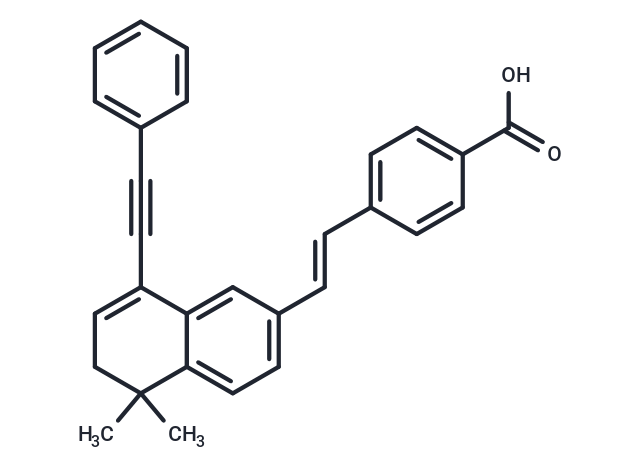Shopping Cart
- Remove All
 Your shopping cart is currently empty
Your shopping cart is currently empty

BMS493 is an inverse agonist of the pan-retinoic acid receptor (RAR) that inhibits retinoic acid-induced differentiation, enhances the interaction of nuclear co-inhibitors with RARs, attenuates RA signaling, potentiates TPP-induced toxicity, and inhibits the increase in phospholipase A2 activity.

| Pack Size | Price | Availability | Quantity |
|---|---|---|---|
| 1 mg | $49 | In Stock |
| Description | BMS493 is an inverse agonist of the pan-retinoic acid receptor (RAR) that inhibits retinoic acid-induced differentiation, enhances the interaction of nuclear co-inhibitors with RARs, attenuates RA signaling, potentiates TPP-induced toxicity, and inhibits the increase in phospholipase A2 activity. |
| In vitro | Cells treated with BMS 493 (100 nM; 6 days) showed a twofold increase in the number of ALDHhi cells available for transplantation compared to untreated controls. Newly expanded ALDHhi cells exhibited increased numbers of CD34 and CD133-positive cells, along with a reduction in CD38 expression[1]. |
| In vivo | In contrast to freshly isolated ALDHhi cells, 6-day expansion with or without BMS 493 generated progeny that were unable to reduce hyperglycemia after iPan transplantation into STZ-treated NOD/SCID mice[1]. |
| Alias | BMS-493 |
| Molecular Weight | 404.5 |
| Formula | C29H24O2 |
| Cas No. | 215030-90-3 |
| Smiles | CC1(C)CC=C(C#Cc2ccccc2)c2cc(\C=C\c3ccc(cc3)C(O)=O)ccc12 |
| Relative Density. | 1.21 g/cm3 (Predicted) |
| Storage | store at low temperature | Powder: -20°C for 3 years | In solvent: -80°C for 1 year | Shipping with blue ice. | ||||||||||||||||||||||||||||||
| Solubility Information | DMSO: 30 mg/mL (74.16 mM), Sonication is recommended. | ||||||||||||||||||||||||||||||
Solution Preparation Table | |||||||||||||||||||||||||||||||
DMSO
| |||||||||||||||||||||||||||||||

Copyright © 2015-2024 TargetMol Chemicals Inc. All Rights Reserved.